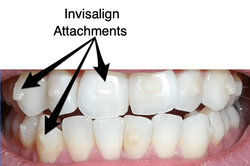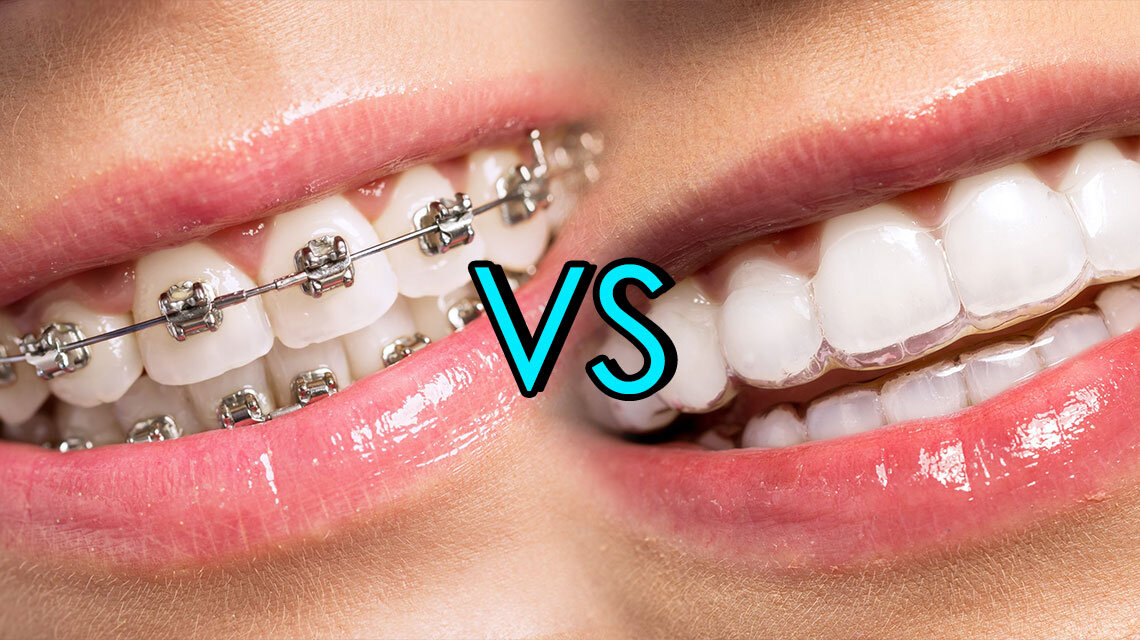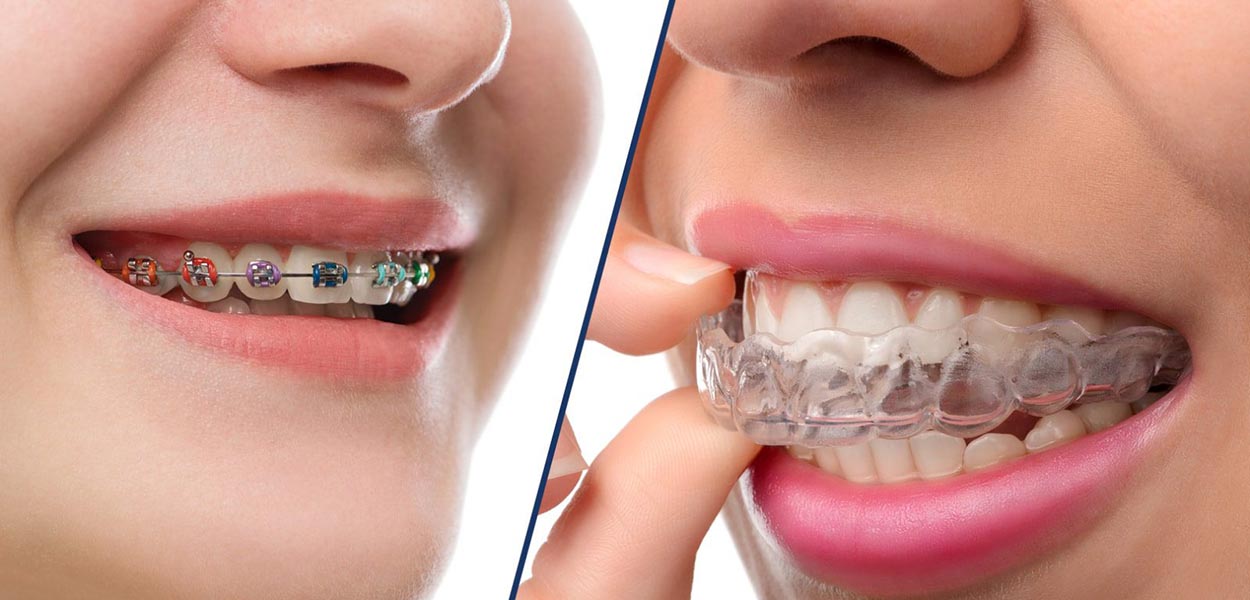How Invisalign Functions: Your Overview to Clear Aligners and Their Effectiveness
How Invisalign Functions: Your Overview to Clear Aligners and Their Effectiveness
Blog Article
Invisalign vs. Conventional Braces: Which Option Is Right for You?
When taking into consideration orthodontic treatment, the option in between Invisalign and conventional braces provides a number of crucial elements that merit careful assessment. Invisalign offers a discreet alternative with removable aligners, while conventional dental braces supply a much more visible yet effective service for serious misalignment.
Summary of Therapy Alternatives

In contrast, typical dental braces contain steel braces and wires that are adhered to the teeth. This technique uses continuous pressure gradually to achieve placement. While effective for complex orthodontic issues, typical dental braces need routine gos to for changes and can position obstacles in keeping dental health as a result of the problem of cleansing about brackets and cords.
Both alternatives have their values, and the option frequently depends upon particular dental problems, way of living preferences, and individual conformity. Ultimately, getting in touch with an orthodontic expert is critical for identifying one of the most appropriate treatment strategy tailored to specific requirements. Understanding the subtleties of each alternative can considerably affect the general success of orthodontic therapy.
Visual Factors To Consider
A significant variable influencing the selection between Invisalign and standard braces is the visual appeal each therapy provides. Invisalign aligners are crafted from clear plastic, making them basically unnoticeable when worn. This discreet look is especially appealing to grownups and teens who might feel uneasy about their orthodontic treatment. The ability to maintain a natural smile throughout the alignment procedure can dramatically enhance the client's self-confidence in expert and social setups.
In contrast, conventional dental braces are composed of steel brackets and cords, which can be more visible. While advancements in orthodontic modern technology have led to the development of smaller brackets and colored elastics, typical braces still keep a more noticeable profile. For some individuals, the presence of dental braces might hinder them from seeking required treatment.
Ultimately, the option between Invisalign and standard braces may depend upon individual preferences concerning aesthetics. Clients who prioritize discretion typically favor Invisalign, while those that are much less concerned concerning presence may go with typical dental braces. Recognizing the visual effects of each choice is crucial for making an educated choice that lines up with one's way of life and preferences.
Convenience and Convenience

In terms of ease, Invisalign aligners are removable, making it possible for clients to appreciate their favorite foods without constraint and keep optimum dental health. Cleaning and flossing are streamlined, as the aligners can be obtained Discover More throughout these routines, whereas typical dental braces require cautious navigating around cables and brackets.
In comparison, typical dental braces demand routine adjustments, making them less hassle-free for those with active schedules. On the whole, the comfort and convenience of Invisalign make it an attractive choice for lots of individuals looking for orthodontic therapy.
Therapy Period and Performance
While both Invisalign and traditional braces work in dealing with oral misalignments, the period of therapy can vary considerably in between the 2 choices. Normally, Invisalign therapy can take anywhere from 12 to 18 months, relying on the complexity of the instance. The clear aligners work by gradually moving teeth into their desired placements, and regular follow-ups with an orthodontist assistance guarantee development continues to be on the right track.
In comparison, traditional dental braces usually need a longer dedication, normally ranging from 18 months to 3 years. This is because of their set nature and the use of cables and braces, which can be much more effective for serious imbalances and complex instances (Invisalign). The therapy performance of conventional braces is well-documented, as they enable for precise modifications and higher control over tooth activity
Ultimately, the option between Invisalign and standard braces might depend upon both the anticipated treatment period and the particular oral issues at hand. Consulting with an orthodontist is critical, as they can give tailored referrals based upon individual requirements, making sure the chosen technique aligns with wanted results and durations.
Price Contrast and Insurance Policy Options
Expense plays a considerable role in the decision-making procedure for individuals thinking about orthodontic treatment, whether choosing Invisalign or standard dental braces. Generally, the expense of Invisalign varieties from $3,000 to $8,000, while typical dental braces normally cost in between $2,000 and $6,000. Aspects affecting these prices consist of the complexity of the case, the period of treatment, and geographical area.
Insurance coverage can dramatically influence out-of-pocket expenditures. Numerous oral insurance coverage strategies supply partial insurance my company coverage for orthodontic therapies, yet the specifics can differ commonly. It is vital for individuals to examine their insurance plan to establish the level of protection for either alternative. Normally, typical braces might be extra often covered by insurance policy strategies compared to Invisalign, which some insurance companies classify as an aesthetic procedure.
Furthermore, a number of orthodontic practices supply flexible settlement plans, making both treatment choices much more accessible. Clients ought to ask about potential funding alternatives and price cuts for in advance payments. Assessing the overall cost, including insurance coverage advantages and settlement plans, is crucial for making a notified choice that lines up with both visual preferences and budget plan factors to consider.

Conclusion
In recap, the selection between Invisalign and standard braces hinges on several elements, including aesthetic choices, comfort, therapy duration, and price. Invisalign provides a discreet, detachable option that facilitates oral health and dietary versatility, while conventional braces might be better for complicated dental concerns and commonly come at a lower cost point. Eventually, appointment with an orthodontist is necessary to analyze private scenarios and determine one of the most appropriate treatment option for achieving optimum oral placement.
When thinking about orthodontic treatment, the option in between Invisalign and standard dental braces presents a number of essential factors that merit mindful assessment.Contrasting Invisalign and standard dental braces exposes distinctive treatment options for you can try these out orthodontic correction.While both Invisalign and standard dental braces are reliable in dealing with dental misalignments, the period of treatment can vary substantially between the 2 alternatives.Expense plays a considerable function in the decision-making process for individuals thinking about orthodontic treatment, whether deciding for Invisalign or typical dental braces.In recap, the option in between Invisalign and conventional braces hinges on multiple factors, consisting of visual choices, comfort, therapy period, and expense.
Report this page